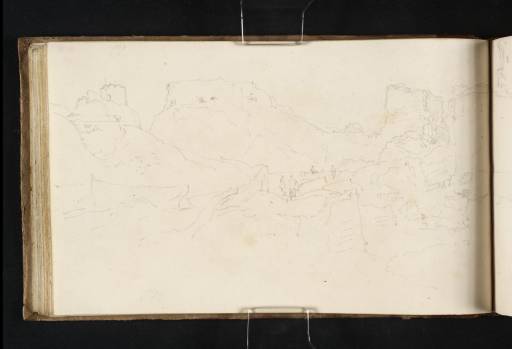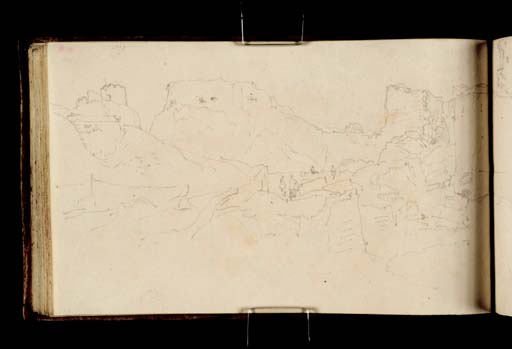Joseph Mallord William Turner Dunbar Castle 1818
Image 1 of 2
Joseph Mallord William Turner,
Dunbar Castle
1818
Joseph Mallord William Turner 1775–1851
Folio 30 Verso:
Dunbar Castle 1818
D13633
Turner Bequest CLXVII 29a
Turner Bequest CLXVII 29a
Pencil on white wove paper, 112 x 186 mm
Inscribed in pencil by Turner ‘[?]Red | Wall’ top left
Inscribed in pencil by Turner ‘[?]Red | Wall’ top left
Accepted by the nation as part of the Turner Bequest 1856
References
1909
A.J. Finberg, A Complete Inventory of the Drawings of the Turner Bequest, London 1909, vol.I, p.485, CLXVII 29a, as ‘Dunbar.’.
1979
Andrew Wilton, J.M.W. Turner: His Life and Work, Fribourg 1979, p.426 under cat.1066.
1999
Katrina Thomson, Turner and Sir Walter Scott: The Provincial Antiquities and Picturesque Scenery of Scotland, exhibition catalogue, National Gallery of Scotland, Edinburgh 1999, p.92 cat.34 fig.25.
2007
Ian Warrell (ed.), J.M.W. Turner, exhibition catalogue, National Gallery of Art Washington, Dallas Museum of Art, Metropolitan Museum of Art, London 2007, p.104.
As Finberg noted, this double-page sketch (continued on folio 31; D13634; CLXVII 30) relates to the ‘Engraving in part IX. Of Scott’s “Antiquities” R.197’, which is the engraving after Turner’s Dunbar Castle, circa 1823 (private collection).1 Unlike some of the other Provincial Antiquities subjects, such as Bass Rock, circa 1824 (Lady Lever Art Gallery, Port Sunlight),2 which were based on a composite of different sketches, this drawing was clearly intended from its completion as the basis of the finished design (although he did utilise other studies). The level of detail and finish exceed that of all the other Dunbar sketches in the Scotch Antiquities sketchbook (see folio 18 verso; D13615; CLXVII 17a), and there is a strong sense of composition, with the castle neatly filling the space of the two pages, that is preserved in the final design (although more is added at the top and bottom). Furthermore, Turner has added a number of figures in the centre of the present page, indicating the details that would be added to the subject in the studio, and suggesting that even as he stood in front of the subject (unless they were added later) he was beginning to think beyond mere topography and plan the theme of the subject and incidents in the picture.
The castle is seen from the east, probably from the nearby Dunbar Battery, so that we look across what is now the harbour basin towards the rocky promontory on which the castle was built. The first stone castle was built on the site in the eleventh century, and it underwent numerous reconstructions before the Scottish Parliament ordered it to be destroyed to prevent it from falling into the wrong hands in the late sixteenth century. Turner sketched the ruins before much of what remained was destroyed to make way for a new harbour entrance in 1844. At the left is the Southern Battery, with what Walter Scott described as the castle gate in the centre of the picture (left of folio 31), and what is presumably the foundation of the Keep at the right (no longer extant).3 In the centre of the present page are four or five figures which help to demonstrate the scale of the other objects.
A sketch on folios 33 verso–34 (D13639–D13640; CLXVII 31c–32) has a very similar viewpoint to this drawing, and was probably made as a supplement to it. In the former Turner almost ran out of room at the top of the page, something that is rectified in the present sketch which shows a slightly wider panorama, and places the castle lower down on the page. In this second version the two parts of the gate are placed further apart making its structure more distinct. It is this latter sketch, rather than the former, that forms the basis for this part of the final picture. The steeper slope of the promontory is similarly taken from this sketch, and the foreground detail informs the final composition. A drawing in the Edinburgh, 1818 sketchbook (Tate D13496–D13497; Turner Bequest CLXVI 23a–24) is also very similar in composition to these two and probably had a bearing on the final picture, especially in the appearance of the gate (folio 25), and the foreground rocks at the left (folio 24 verso).
There is a pale pink mark at the top left, transferred from Ruskin’s original red ink numbering on the opposite page which has now faded.
Thomas Ardill
March 2008
How to cite
Thomas Ardill, ‘Dunbar Castle 1818 by Joseph Mallord William Turner’, catalogue entry, March 2008, in David Blayney Brown (ed.), J.M.W. Turner: Sketchbooks, Drawings and Watercolours, Tate Research Publication, December 2012, https://www


